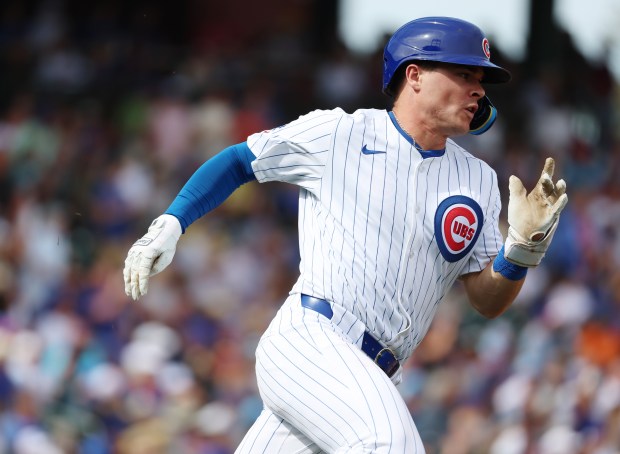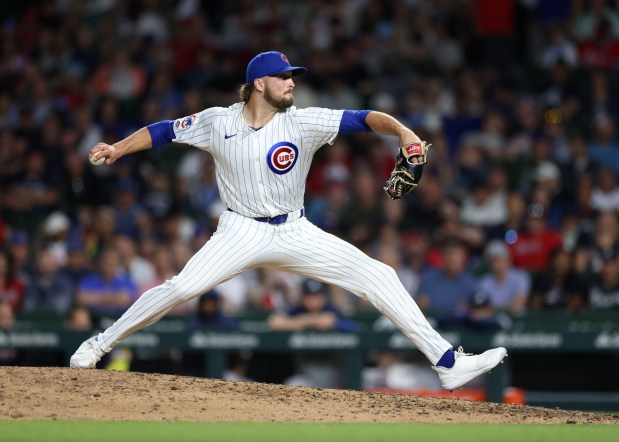As Major League Baseball teams prepare to descend on Dallas for next week’s winter meetings, the Chicago Cubs still have a lot of work to do.
The Cubs, fresh off agreeing to a two-year deal with left-hander Matthew Boyd, head into the annual gathering seeking to upgrade an 83-win postseason-less roster. As the organization continues to evaluate its options, three storylines stand out for the Cubs.
1. What will the Cubs do with Cody Bellinger?
The Cubs’ pathway to improving what has been an inconsistent offense the last two years might require some tough decisions if they don’t want to run it back with the same 2024 group. That would necessitate a deal, with three players — Ian Happ, Seiya Suzuki and Dansby Swanson — holding no-trade clauses.
The most obvious option is moving Bellinger, whose defensive flexibility and power from the left side are an attractive combination. However, Bellinger’s 2025 player option will pay him $27.5 million, and he holds another option for 2026 worth $25 million ($5 million buyout). It’s a potential hefty cost for an acquiring team, depending on whether the Cubs opt to take on a chunk of his money owed for a better return or clear his salary and, theoretically, reinvest that money elsewhere on the roster.
Bellinger’s future with the Cubs should gain clarity once slugger Juan Soto signs his mega contract that might happen within the next week, according to reports. The perception around MLB is that the Cubs are motivated to trade the 29-year-old Bellinger. That could either help them if enough teams express interest — or hinder the organization by weakening the Cubs’ leverage.
Bellinger’s ability to play center field, right field and first base creates a variety of avenues for other teams to upgrade their lineups. And while where Soto signs could affect potential suitors, if he returns to the Bronx, that would not preclude the Yankees from also adding Bellinger, who would remain a viable option for them, a source told the Tribune, because of where he can play in the field and how his lefty bat could play at Yankee Stadium.
The only way trading Bellinger makes sense for the Cubs, however, is if they find a proven offensive upgrade through free agency or a trade. The Cubs lineup needs more slug and a threat in the middle of the lineup, and one way or another they must pay for that.
2. How will the Cubs address their bullpen issues?
The bullpen remains the most notable area the Cubs must overhaul.
Only six relievers appeared in at least 25 games for the Cubs, three of whom — Drew Smyly, Mark Leiter Jr. and Héctor Neris — are no longer with the organization and one — Luke Little — who didn’t pitch after July 12 because of a season-ending lat strain.
That leaves right-handers Tyson Miller (2.15 ERA in 49 games) and Porter Hodge (1.88 ERA and nine saves in 39 games), the latter coming off his first major-league season, among the notable returners, joined by right-handers Nate Pearson, Julian Merryweather and Keegan Thompson. A key piece of their 2023 bullpen, Merryweather was limited to 15 appearances in 2024 from two injuries, including season-ending patellar tendon debridement surgery in September.
The Cubs desperately need proven relievers to shore up the back end of the pen. Adding Eli Morgan from the Cleveland Guardians helps with their depth, and the Cubs could explore again using Ben Brown or Hayden Wesneski in a relief role. They’ve also made low-risk acquisitions by claiming lefty Rob Zastryzny off waivers in November and agreed to minor-league contracts with invitations to big-league camp with right-handers Brooks Kriske and Phil Bickford.
But they still need more quality arms for high-leverage outs while building adequate depth to sustain early-season injuries or performance issues, something they couldn’t overcome in 2024. The Cubs farm system will give them options to find those upgrades in trades like the one they completed for Morgan last month if they don’t want to delve too deeply into the free-agent relief market.
3. How will they handle a glut of upper-level prospects?

The Cubs are reaching a point where finding some at-bats for their top prospects would be valuable. How they manage that depends on the level of experience they want on their big-league bench and if they can find the right balance of playing time.
Among players on the 40-man roster, outfielder Alexander Canario is out of minor-league options and would need to open the season on the team barring a trade, while outfielder Owen Caissie, who was added to the 40-man roster last month to protect him from the Rule 5 draft, gives them upside depth if there is an injury among the outfielders. They gave outfielder Kevin Alcántara his first major-league call-up in late September, though he still has a minor-league option, giving the Cubs some flexibility.
But with that trio of outfield prospects, infielders Matt Shaw and James Triantos and catcher/designated hitter Moises Ballesteros all spending at least the final six weeks with Triple-A Iowa, the Cubs face decisions on how they want to best utilize their position-player prospect talent. If they decide for a more creative route to shake up the lineup with pre-arbitration or arb players on their roster, they could test the market for Isaac Paredes or Michael Busch.
Shaw appears the most ready to help the Cubs, and there is a possible path to big-league at-bats early in the season if they are willing to put him on the 40-man roster. Second baseman Nico Hoerner’s availability for the beginning of the season is unclear. He underwent surgery on the flexor tendon in his right forearm on Oct. 11, and the Cubs will see where Hoerner is at in the recovery and rehab process when he reports to spring training. Position players typically return more quickly from this procedure than pitchers; outfielder David Peralta, who was in camp with the Cubs last spring, needed 5½ months post-surgery before he played in games for Iowa.
Hoerner is a potential trade candidate, but his surgery creates some unknowns for interested teams, both with a clear timeline for his readiness and the risk that can come from acquiring him before seeing how he looks on the field at 100% health. The Cubs don’t necessary need to move him as Hoerner, 27, will earn a reasonable $11.5 million in 2025 and $12 million the following year.



